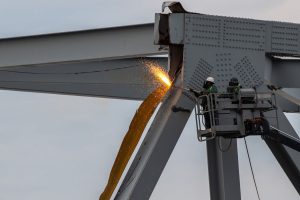US ports detail investment plans following US$ 2.9bn Clean Ports Program awards
NewsPorts across the US outline targeted plans to utilise EPA funding to accelerate the shift to zero-emission equipment and infrastructure.
The Unified Command commenced bridge wreckage removal on Saturday to eliminate debris from the Francis Scott Key Bridge collapse.

The Unified Command, which has been established in Baltimore to coordinate the response to the collapse of the Francis Scott Key Bridge, has commenced cutting operations aimed at removing the wreckage from the water channel, which is blocking entry into the Port of Baltimore.
Reopening the channel to vessel traffic has been identified as the main priority having in mind the importance of the port for the Maryland and U.S. economy.
What is more, the closure of the ports has directly affected at least 8,000 dock workers.
Governor of the State of Maryland, Wes Moore’s has secured $60 million in federal emergency relief to support mobilization, operations, and debris removal.
“Highly trained demolition crews are cutting the top portion of the north side of the collapsed bridge truss. Two crane barges, a 650-ton crane and a 330-ton crane, are actively working on scene. The removed wreckage is scheduled to be lifted and transferred to a barge this evening as daylight allows. A 230-ton land-based crane will offload and process the wreckage at Tradepoint Atlantic and will then be taken to a disposal site,” the command said in its latest update on March 30.
U.S. Army Corps of Engineers plans to activate more than 1,000 personnel for the task.

As informed, salvage teams will use gas-powered cutters to systematically separate sections of the steel bridge, which will be taken to a disposal site. At the same time, salvage divers will continue to conduct underwater assessments of the work site to support further operations. Every lifting operation requires engineering analysis to inform salvage operation plans.
The first step is to open one-way vessel traffic into the inner harbor to enable the resumption of vessel handling.
First salvage step is to open one-way traffic to Baltimore harbor, USACE says
The Unified Command is working in partnership with BGE to reduce pressure of an underwater pipeline that spans the width of the channel and runs under the incident site. Efforts are underway to inert the pipeline to free it from hazards and risk. Pipeline operations are expected to continue through the weekend.
A 2000-yard maritime Safety Zone for the M/V Dali recovery efforts is still being enforced. A temporary flight restriction with a radius of three nautical miles from the surface, up to and including 1,500 feet above ground level also remains in effect.
It remains unclear when will the Port of Baltimore open for vessel traffic, the port authority said.
“As you know, vessel traffic into and out of the Port of Baltimore remains suspended. Trucks, however, are still being processed inside our marine terminals,” the port said.
“There is a lot of speculation as to when the channel will be reopened. The fact of the matter is we do not know.”